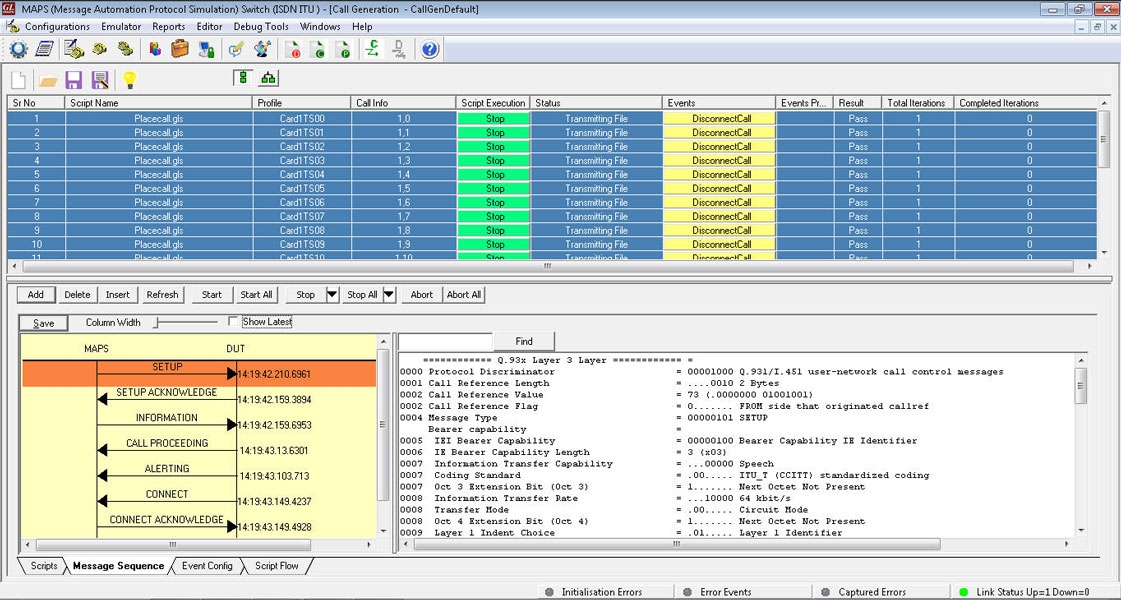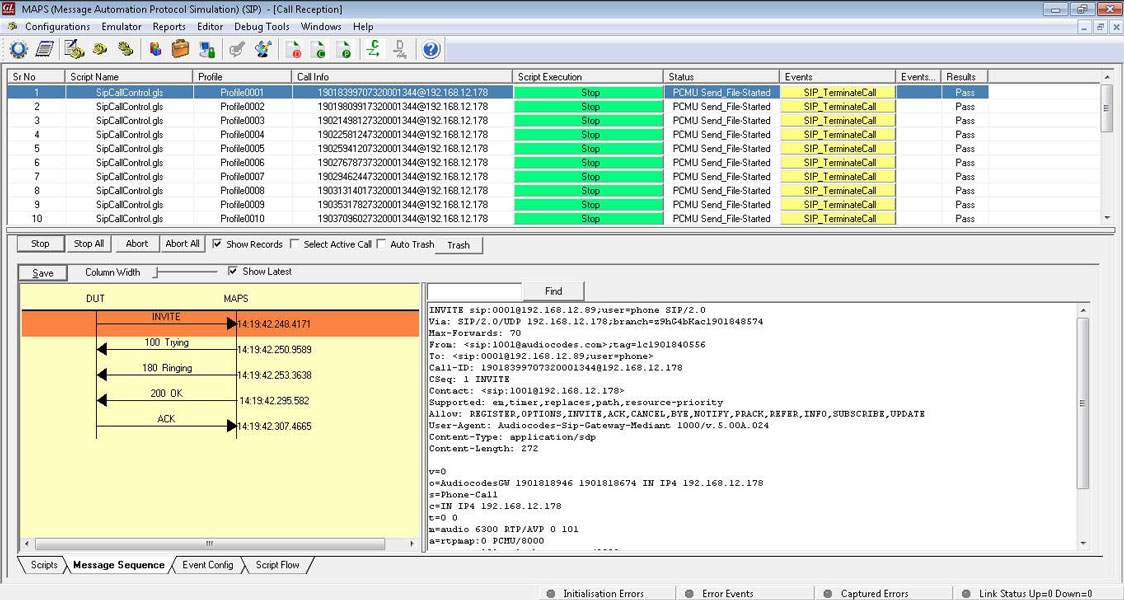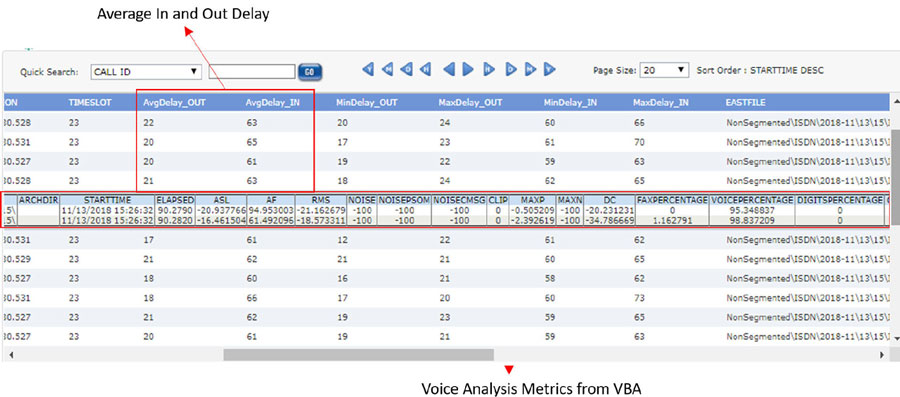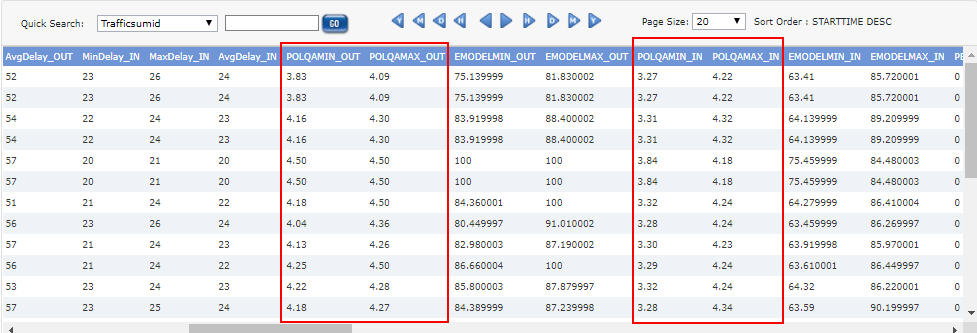Gateway/Router Performance Measurements
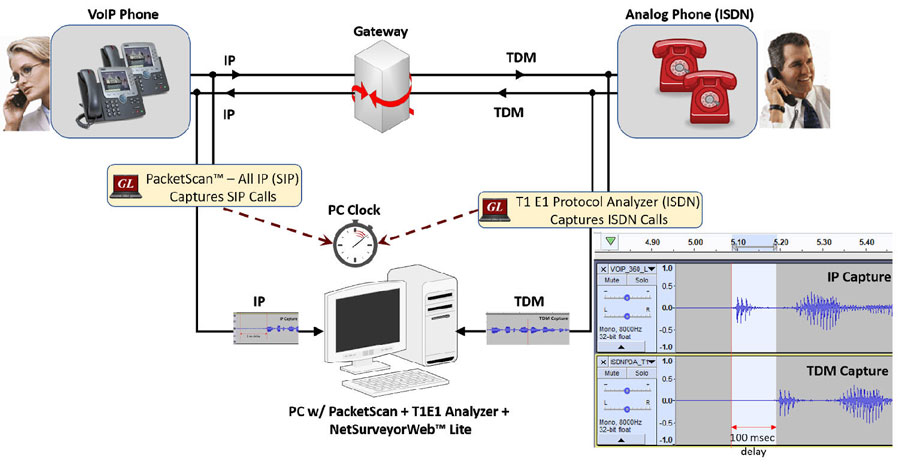
Overview
Signaling and voice that traverse through various network elements including gateways, routers, and switches may suffer impairments in voice delay, voice quality, signaling delay, and congestion. Performance measurement tools can help quantify the degradation whether occurring in individual elements or in the end to end path.
The traffic which traverses through a Router/Gateway can be captured at both TDM and IP interfaces simultaneously (synchronized to a common clock) and stored in a common codec format e.g. *.pcm. These captured voice segments can be further processed using GL's Delay and Voice analysis applications:
- Delay measurement module compares the samples based on the timestamp and provides the delay metrics such as One-Way Delay (OWD), Round Trip Delay (RTD), Post Dial Delay (PDD), Signal-to-Noise Ratio (SNR).
- Voice Quality Analysis (VQT) supports analysis of these captured segments using POLQA/PESQ algorithm providing MOS, E-Model, Signal Level, Noise Level, and Jitter metrics.
- Real-time Voice-band Analyzer (VBA) supports analysis of captured voice band traffic and provides statistics such as Active Speech Level, Activity Factor, RMS Factor, DC Level, Noise Level, Echo Return Loss, Echo Delay, and Echo Dispersion.
GL’s NetSurveyorWeb™ Lite an integrated and simplified web-based system works with GL’s TDM/IP Protocol Analyzers, Voice Band Analyzer, and Delay Measurement tools to analyze captured voice traffic and provide precise voice and one-way delay metrics.
Main Features
- Reports important protocol signaling information
- Remote monitoring capability using GL's Network Surveillance System
- Provides various Signaling Key Performance Indicators (KPI’s) such as Call Success Ratio, Failure Calls, Call Failure Cause, Setup Duration, and Billing Duration (TDM)
- Provides Voice Quality KPIs based on Voice Quality (MOS, R-Factor), Delay Measurements (RTD, OWD), and speech Metrics
- Provide accurate One-way delay measurements
- Speech Metrics (Active Speech Level, Activity Factor, Noise Level, DC, RMS)
- Capture SS7 calls on multiple T1 E1 trunks using a signaling link on a different physical trunk than the telephony circuits
How Router/Gateway Delay is Calculated
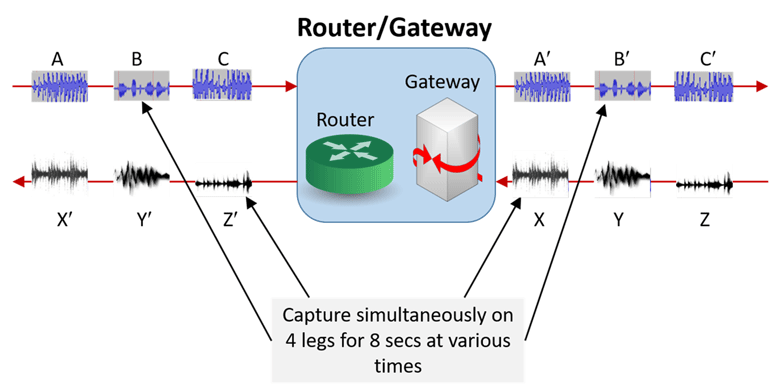
Router/ Gateway Delay Calculation
In order to calculate the delay both the reference and the degraded captures are analyzed simultaneously, bursts segments from reference capture are looked up in the degraded capture and the difference in the occurrences of these bursts on timeline from the start of the capture gives the delay. When several matching bursts are found among these files an average delay score is generated.
As per the figure above, 3 reference & degraded captures per minute are created in each direction of data flow i.e., IP to TDM and TDM to IP and an average delay score is generated at the end of the call for each direction.
The delay measurement in left direction, i.e., the bursts A, B, C recorded forms the reference capture and the bursts A', B', C' forms the degraded capture, the delay then would be average of (tA' - tA & tB' - tB & tC' - tC).
ISDN/SS7 Protocol Analyzer
The analyzer displays Summary, Detail, and Hex Dump Views in different panes. The ISDN Summary View displays Device Number, Frame Number, Time, Length, C/R, SAPI, TEI,P/F, N(S),N(R), Func, CRV, Called and Calling No and so on. The SS7 Summary View displays Frame Number, Time, Length, BSN, BIB, FSN, FIB, SCCP message type, called / calling number, and so on. User can select a frame in Summary View to analyze and decode each frame in the Detail View. The Hex dump View displays the frame information in HEX and ASCII octet dump formats. The contents of detail and hex dump view can also be copied to clipboard.
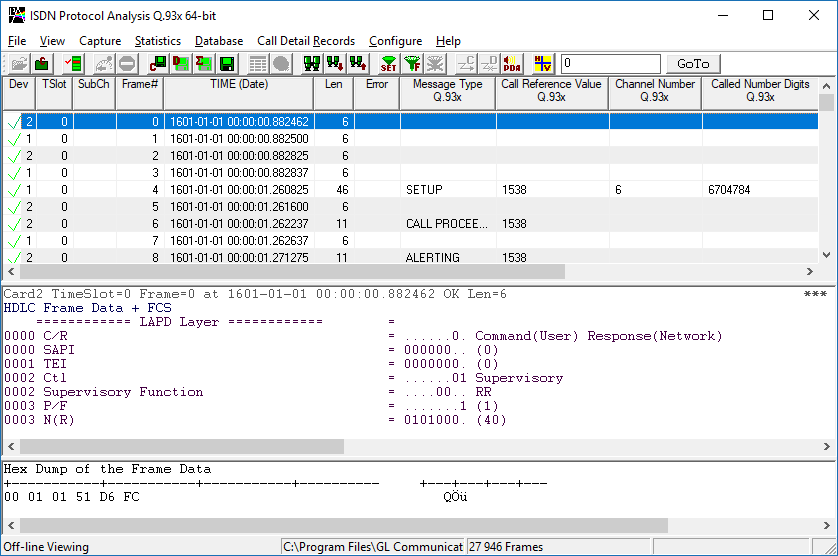
ISDN Protocol Analyzer
For more information, refer to ISDN Protocol Analyzer and SS7 Protocol Analyzer.
Bulk Call Generation using MAPS™ Emulation
GL's Message Automation & Protocol Simulation (MAPS™) is a protocol simulation and conformance test tool that supports a variety of protocols such as SIP, MEGACO, MGCP, SS7, ISDN, GSM, MAP, CAS, LTE, UMTS, SS7 SIGTRAN, ISDN SIGTRAN, SIP I, GSM AoIP, Diameter and others.
GL's MAPS™ is designed to work on TDM interfaces as well as on the IP/Ethernet interfaces. TDM signaling protocols such as SS7, ISDN, MLPPP, CAS, MAP, CAP, GSM, INAP, and BICC operate over TDM networks, whereas VoIP protocols SIP, SIP-I, MEGACO, MGCP, SIGTRAN, Diameter, INAP, MAP, CAP, and BICC operate over IP transport layer.
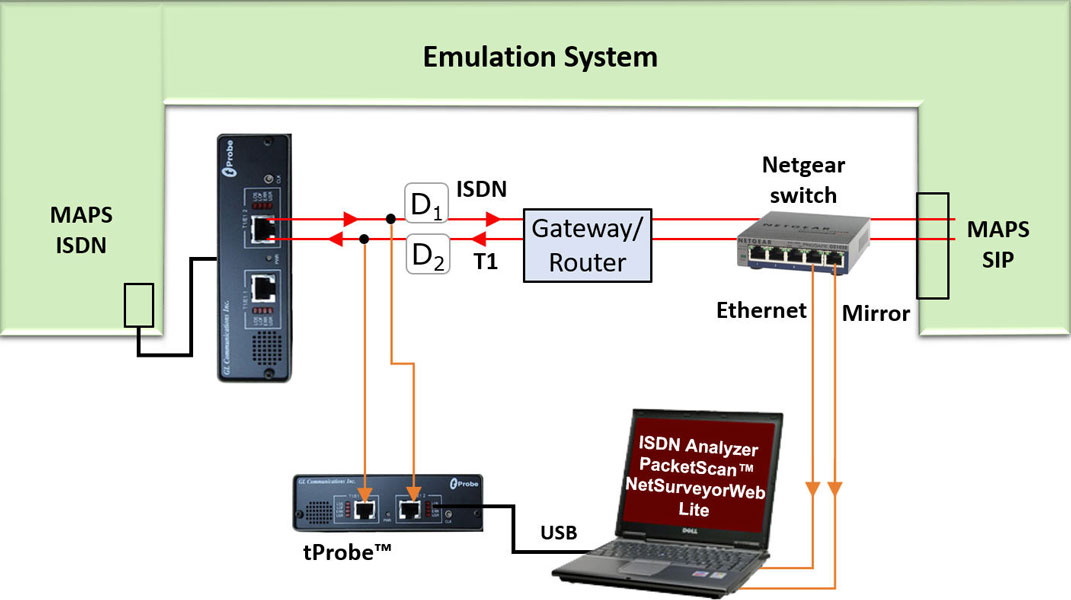
The above setup depicts MAPS ISDN application is used to generate bulk calls and MAPS SIP is used to receive SIP calls at the other end. GL’s MAPS™ ISDN is an advanced protocol simulator/tester for ISDN simulation over TDM (T1 E1) and generates high volumes of ISDN traffic. The tester can simulate ISDN signaling as defined by ITU-T Q.931, 5ESS, 4ESS, BELL, DMS-100, DMS-250, and QSIG ECMA standards.
The MAPS™ SIP testing can simulate User Agents (User Agent Client- UAC, User Agent Server-UAS), Proxy, Redirect, Registrar and Registrant servers. The application gives the users the unlimited ability to edit SIP messages and control scenarios (message sequences). "Message sequences" are generated through scripts. "Messages" are created using message templates.
The following are the MAPS ISDN Call Generation and MAPS SIP Call Reception window.
For more information, refer to MAPS™ SIP and MAPS™ ISDN
Voice Quality and Delay Metrics in NetSurveyorWeb™ Lite
The NetSurveyorWeb™ Lite system comprises of three tier distributed architecture driven by non-intrusive hardware probes, webserver, intelligent software, and a database engine.
All components of the system reside at the PROBE-PC. The architecture allows to simply deploy it at multiple locations in the network and perform critical measurements.
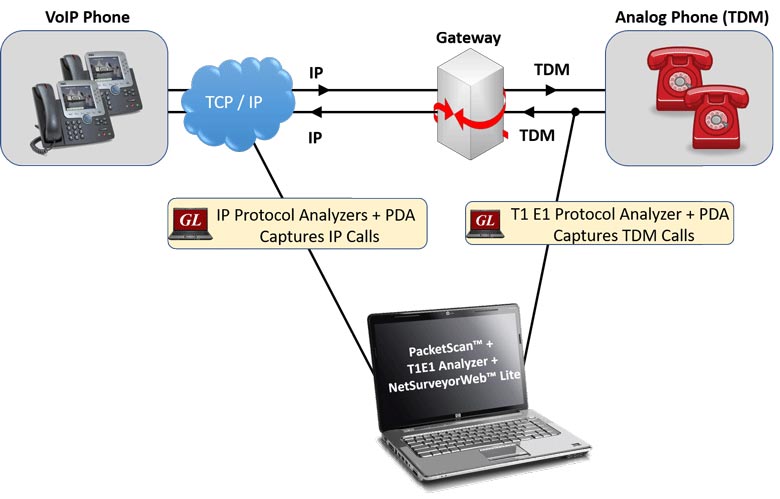
Measuring Delay in NetSurveyorWeb™ Lite
NetSurveyorWeb™ Lite works with Delay Measurement and Voice Quality Analysis tools to analyze captured voice traffic and provide precise one-way delay and Voice Quality (MOS, E-Model, Signal Level, Noise Level, and Jitter) metrics.
All delay metrics from different capture and analysis tools are consolidated in the central database system and is presented in web-browser to drill down to calls-of-interest.
For more information, refer to NetSurveyorWeb™ Lite.
The below KPI shows average delay for In and Out direction. It is categorized as <51 sec, between 51-100 Msec, between 101-150 Msec, and greater than 150 Msec
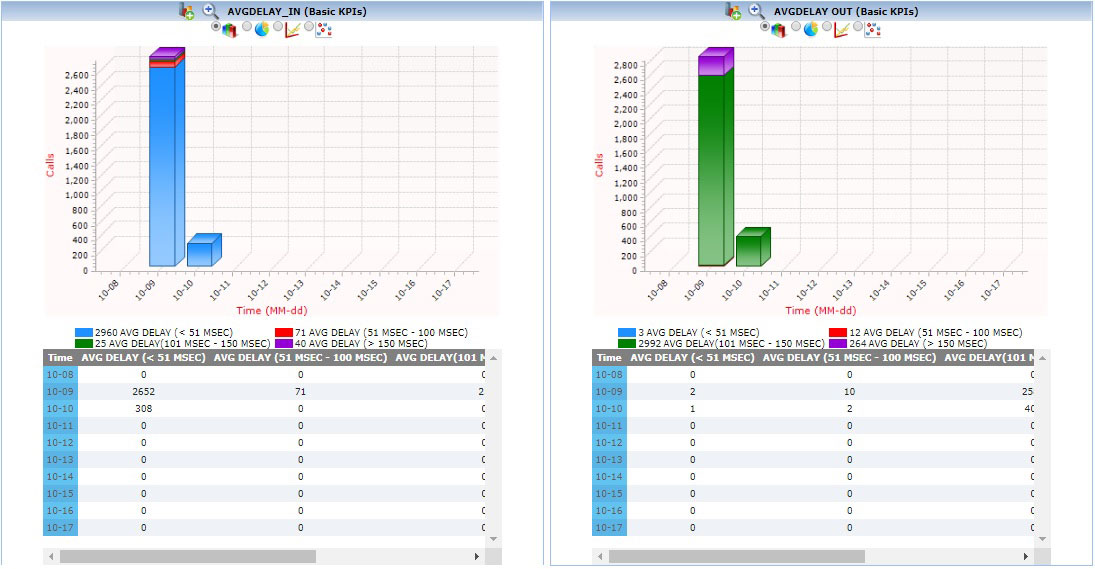
Average Delay In and Out
Resources
Please Note: The XX in the Item No. refers to the hardware platform, listed at the bottom of the Buyer's Guide, which the software will be running on. Therefore, XX can either be ETA or EEA (Octal/Quad Boards), PTA or PEA (tProbe Units), XUT or XUE (Dual PCIe Express) depending upon the hardware.
| Item No. | Item Description |
PKV111 |
|
PKV170 |
NetsurveyorWeb™ (Perpetual License, Unlimited Users/Nodes) |
|
Related Software |
|---|---|
XX100 |
|
XX120 |
|
XX648 |
|
XX649 |
|
For more information on MAPS™ products, visit Maps™ Buyers guide |
|
VBA032 |
|
VQT002 |
|
PKV169 |
Network Surveillance Lite Software (Does not include PC; Includes Oracle 11g Express Edition and requires respective real-time protocol analyzer licenses on the Probe PC) |
Requires one of the following protocol analyzer licenses. |
|
PKV100 |
PacketScan™ (Real-time and Offline) for SIP, MGCP, Megaco, H.323. |
PKV103 |
|
PKV105 |
|
| PKV107 | LTE (Long Term Evolution) Analyzer, requires PKV100 |
| XX150 | GSM Analysis Software (T1 or E1) |
|
Related Hardware |
PTE001 |
tProbe™ Dual T1 E1 Laptop Analyzer |
XTE001 |
|
TTE001 |
|
FTE001 |
|
ETE001 |
|
UTE001 |
|
